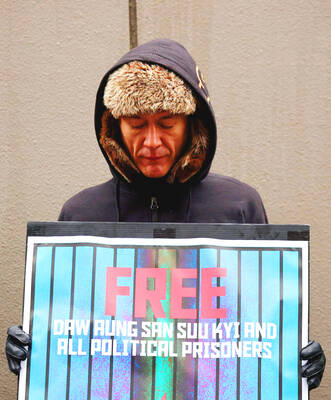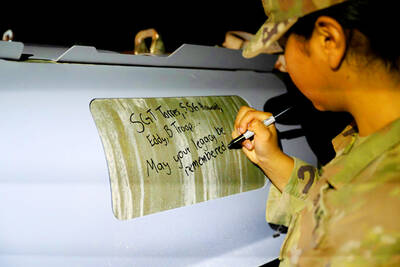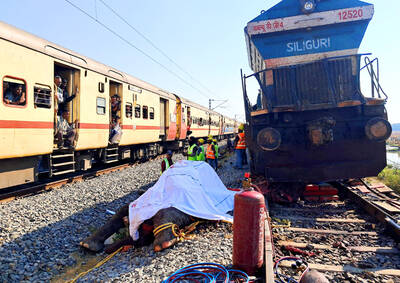The number of people seeking asylum in the West jumped 20 percent last year, with record numbers fleeing conflicts in Libya, Syria and Ivory Coast, the UN refugee agency said yesterday.
The largest regional rise was in those applying for refugee status in southern Europe, it said. Most arrived by boat in Italy and Malta, originating from North Africa or sub-Saharan Africa. Turkey also saw a sharp influx of Iraqis.
Overall, 441,300 asylum claims were registered in 44 industrialized countries last year compared with 368,000 the previous year, with Afghans forming the biggest group, followed by Chinese and Iraqis, the UN High Commissioner for Refugees (UNHCR) said.
“Reflecting turmoil in West Africa and in the Arab world, asylum seekers from Cote d’Ivoire [Ivory Coast], Libya, Syria and other countries reached record levels in 2011, with 16,700 more claims than in 2010,” the Geneva-based agency said in a report.
Last year’s figures were the highest since 2003, when more than 505,000 requests were lodged in industrialized countries.
Asylum and immigration in general is a political flashpoint in many European countries, including Britain, France and Italy, as well as in Australia and the US.
UN High Commissioner for Refugees Antonio Guterres said that it was important to put the latest figures in perspective.
“The number of asylum claims received across all industrialized countries is still smaller than the population of Dadaab, a single refugee camp in northeast Kenya,” he said.
The sprawling Dadaab complex, the world’s largest refugee camp, now shelters 462,856 Somalians who have fled war and drought in their anarchic homeland.
A record 1,500 migrants, mainly from Somalia and other parts of Africa, died trying to reach European shores last year, the UNHCR said on Jan. 31.
About 35,700 Afghans sought asylum in the West last year, a 34 percent jump, and 24,400 Chinese lodged claims, half of them in the US. Iraqis were the third-largest group, filing 23,500 requests in industrialized countries.
Europe was the preferred destination for refugees, with the continent’s 38 countries receiving 327,200 asylum claims, up 19 percent from 2010. The EU, with 27 member states, had 277,400 claims, a rise of 15 percent.
However, the US was again the largest recipient of new asylum claims, accounting for 74,000 applications, or one in six overall. Requests there grew 33 percent, half of them by asylum-seekers from China, Mexico and El Salvador.
Canada had 25,300 applications, a 9 percent rise.
Referring to North America, the UNHCR said: “Although 2011 is the highest level in almost a decade for this region, it is two-thirds that of 2001, when close to 150,000 applications in total were lodged in Canada and the United States of America.”
France had the second-largest number of asylum requests last year at 51,900, up 8 percent, because of more claims from Armenians and Ivorians, although Russians formed the main group.
Germany was third with 45,700, an 11 percent increase, because of higher numbers from Afghanistan, Syria and Pakistan.
The number of asylum-seekers in Australia and New Zealand fell 9 percent last year to 11,800, mainly because fewer would-be refugees arrived in Australia by boat, it said.
Australian Prime Minister Julia Gillard’s asylum policy was thrown into confusion last year when the Australian High Court rejected her plan for a refugee swap with Malaysia. Opposition in parliament then forced the government to abandon tough offshore processing popular with many voters.
“Asylum levels in Australia remain below those recorded by many other industrialized and non-industrialized countries,” the UNHCR said.

The Burmese junta has said that detained former leader Aung San Suu Kyi is “in good health,” a day after her son said he has received little information about the 80-year-old’s condition and fears she could die without him knowing. In an interview in Tokyo earlier this week, Kim Aris said he had not heard from his mother in years and believes she is being held incommunicado in the capital, Naypyidaw. Aung San Suu Kyi, a Nobel Peace Prize laureate, was detained after a 2021 military coup that ousted her elected civilian government and sparked a civil war. She is serving a

REVENGE: Trump said he had the support of the Syrian government for the strikes, which took place in response to an Islamic State attack on US soldiers last week The US launched large-scale airstrikes on more than 70 targets across Syria, the Pentagon said on Friday, fulfilling US President Donald Trump’s vow to strike back after the killing of two US soldiers. “This is not the beginning of a war — it is a declaration of vengeance,” US Secretary of Defense Pete Hegseth wrote on social media. “Today, we hunted and we killed our enemies. Lots of them. And we will continue.” The US Central Command said that fighter jets, attack helicopters and artillery targeted ISIS infrastructure and weapon sites. “All terrorists who are evil enough to attack Americans are hereby warned

Seven wild Asiatic elephants were killed and a calf was injured when a high-speed passenger train collided with a herd crossing the tracks in India’s northeastern state of Assam early yesterday, local authorities said. The train driver spotted the herd of about 100 elephants and used the emergency brakes, but the train still hit some of the animals, Indian Railways spokesman Kapinjal Kishore Sharma told reporters. Five train coaches and the engine derailed following the impact, but there were no human casualties, Sharma said. Veterinarians carried out autopsies on the dead elephants, which were to be buried later in the day. The accident site

‘EAST SHIELD’: State-run Belma said it would produce up to 6 million mines to lay along Poland’s 800km eastern border, and sell excess to nations bordering Russia and Belarus Poland has decided to start producing anti-personnel mines for the first time since the Cold War, and plans to deploy them along its eastern border and might export them to Ukraine, the deputy defense minister said. Joining a broader regional shift that has seen almost all European countries bordering Russia, with the exception of Norway, announce plans to quit the global treaty banning such weapons, Poland wants to use anti-personnel mines to beef up its borders with Belarus and Russia. “We are interested in large quantities as soon as possible,” Deputy Minister of National Defense Pawel Zalewski said. The mines would be part